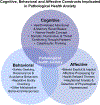Mechanistic studies in pathological health anxiety: A systematic review and emerging conceptual framework
- PMID: 38718945
- PMCID: PMC11298870
- DOI: 10.1016/j.jad.2024.05.029
Mechanistic studies in pathological health anxiety: A systematic review and emerging conceptual framework
Abstract
Background: Pathological health anxiety (PHA) (e.g., hypochondriasis and illness anxiety disorder) is common in medical settings and associated with increased healthcare costs. However, the psychological and neurobiological mechanisms contributing to the development and maintenance of PHA are incompletely understood.
Methods: We performed a systematic review to characterize the mechanistic understanding of PHA. PubMed, PsycINFO, and Embase databases were searched to find articles published between 1/1/1990 and 12/31/2022 employing a behavioral task and/or physiological measures in individuals with hypochondriasis, illness anxiety disorder, and PHA more broadly.
Results: Out of 9141 records identified, fifty-seven met inclusion criteria. Article quality varied substantially across studies, and was overall inadequate. Cognitive, behavioral, and affective findings implicated in PHA included health-related attentional and memory recall biases, a narrow health concept, threat confirming thought patterns, use of safety-seeking behaviors, and biased explicit and implicit affective processing of health-related information among other observations. There is initial evidence supporting a potential overestimation of interoceptive stimuli in those with PHA. Neuroendocrine, electrophysiology, and brain imaging research in PHA are particularly in their early stages.
Limitations: Included articles evaluated PHA categorically, suggesting that sub-threshold and dimensional health anxiety considerations are not contextualized.
Conclusions: Within an integrated cognitive-behavioral-affective and predictive processing formulation, we theorize that sub-optimal illness and health concepts, altered interoceptive modeling, biased illness-based predictions and attention, and aberrant prediction error learning are mechanisms relevant to PHA requiring more research. Comprehensively investigating the pathophysiology of PHA offers the potential to identify adjunctive diagnostic biomarkers and catalyze new biologically-informed treatments.
Keywords: Cyberchondria; Health anxiety; Hypochondriasis; Illness anxiety disorder; Pathological health anxiety.
Copyright © 2024 Elsevier B.V. All rights reserved.
Conflict of interest statement
Declaration of competing interest D.L.P. has received royalties for a Springer Nature textbook on functional movement disorder; is a paid senior editor at Brain and Behavior; has received honoraria for a functional neurological disorder textbook and continuing medical education lectures; has received funding from the Sidney R. Baer Jr. Foundation unrelated to this work; and is on the editorial boards of The Journal of Neuropsychiatry & Clinical Neurosciences, Epilepsy & Behavior, and Cognitive and Behavioral Neurology. All other authors do not have any disclosures or other conflicts of interest.
Figures



References
-
- Abramowitz JS, Moore EL, 2007. An experimental analysis of hypochondriasis. Behaviour Research and Therapy 45, 413–424. - PubMed
-
- Alberts NM, Hadjistavropoulos HD, Jones SL, Sharpe D, 2013. The Short Health Anxiety Inventory: a systematic review and meta-analysis. J Anxiety Disord 27, 68–78. - PubMed
-
- American Psychiatric Association, 2000. Diagnostic and Statistical Manual of Mental Disorders, Fourth Edition: DSM-IV-TR®. American Psychiatric Association.
-
- American Psychiatric Association, 2013. Diagnostic and statistical manual of mental disorders : DSM-5. American Psychiatric Association, Arlington, VA.
-
- Atmaca M, Korkmaz H, Korkmaz S, 2010a. P wave dispersion in patients with hypochondriasis. Neuroscience Letters 485, 148–150. - PubMed
Publication types
MeSH terms
Grants and funding
LinkOut - more resources
Full Text Sources
Medical
Miscellaneous

